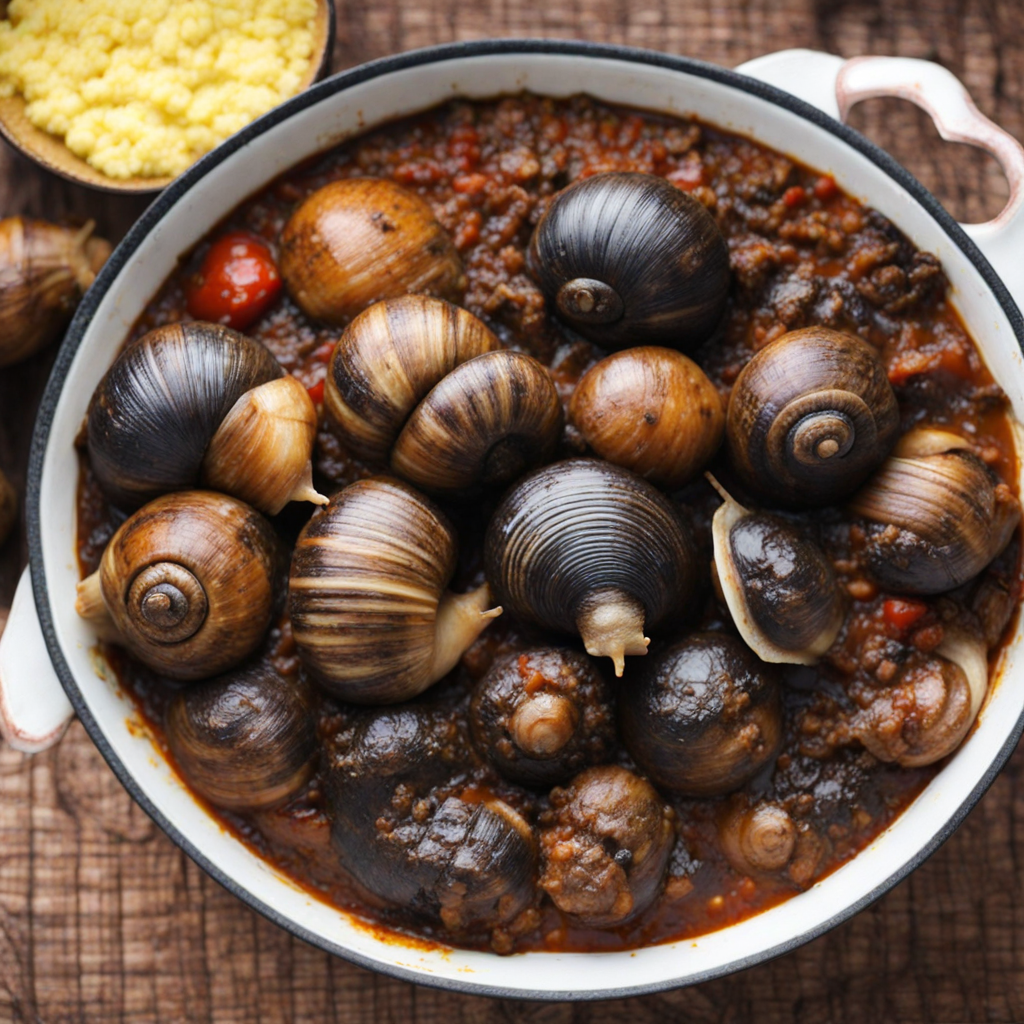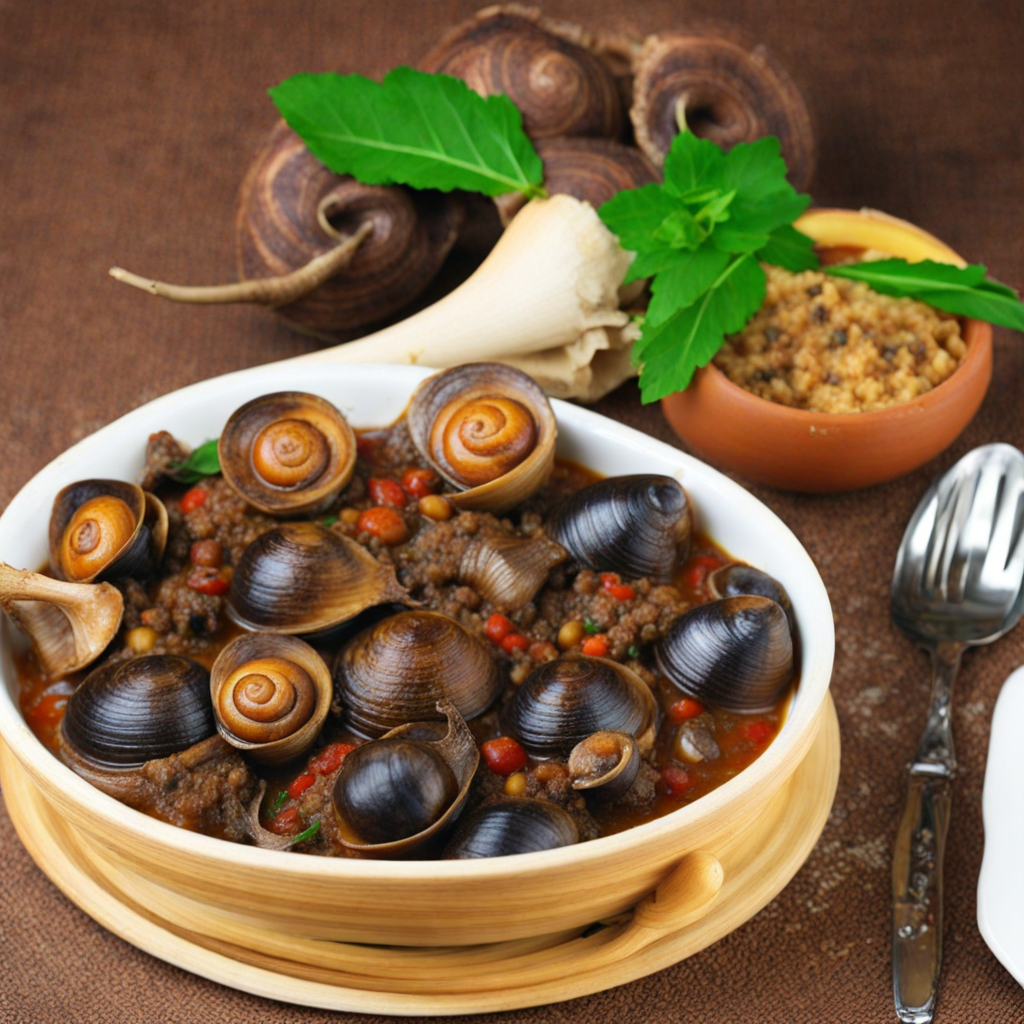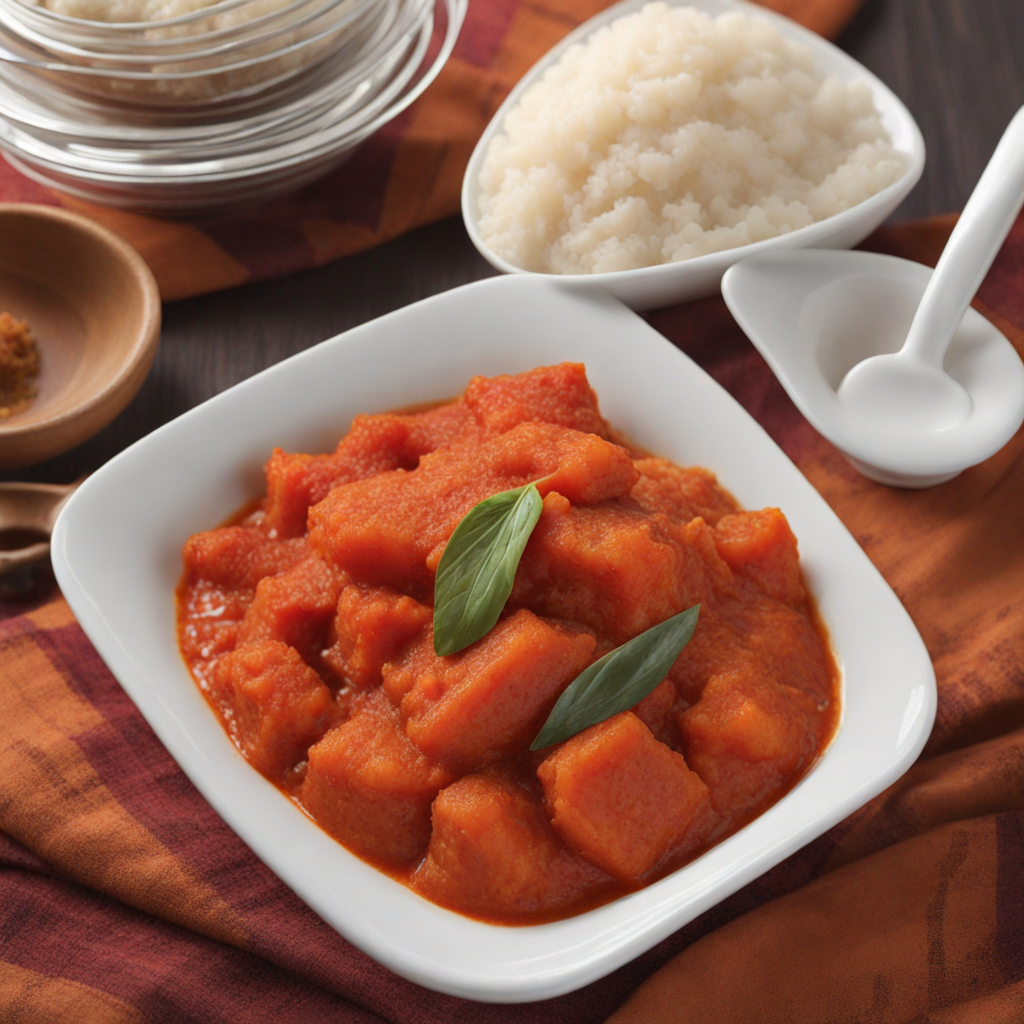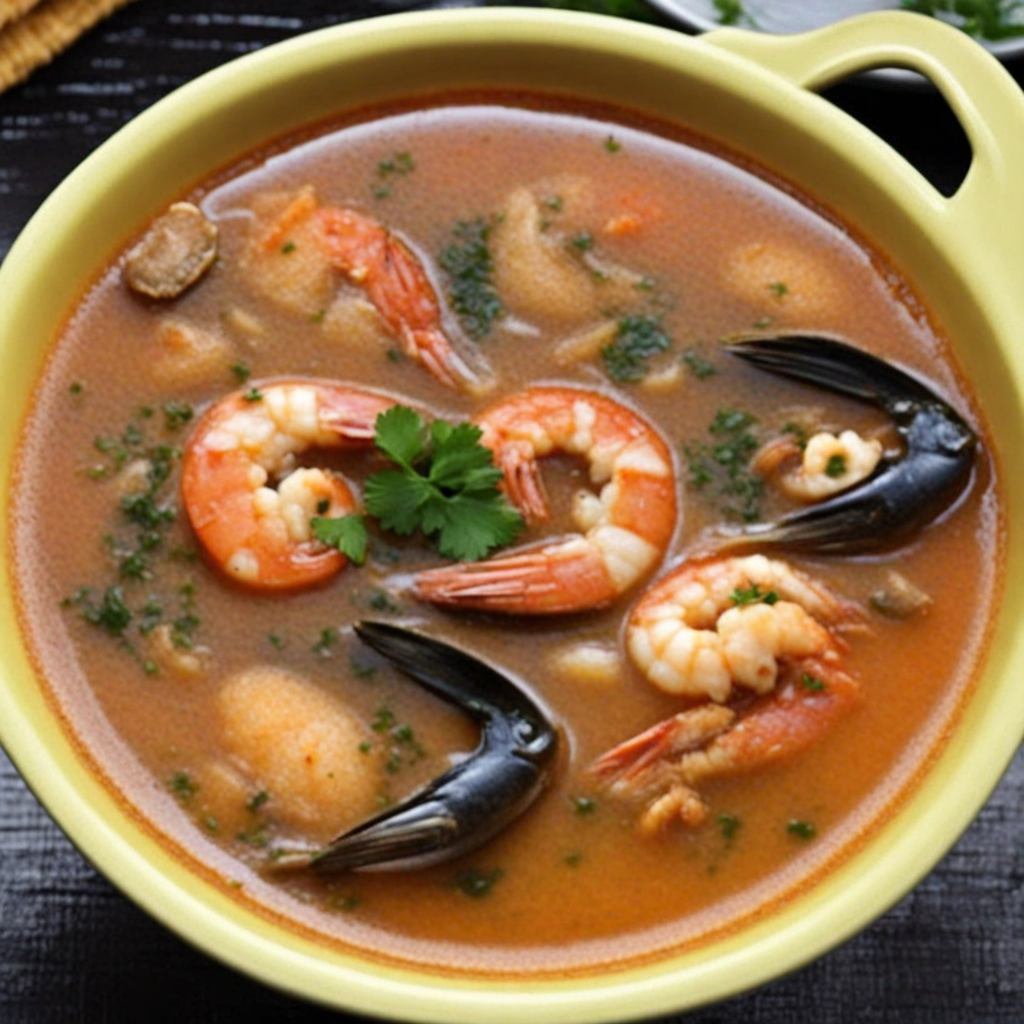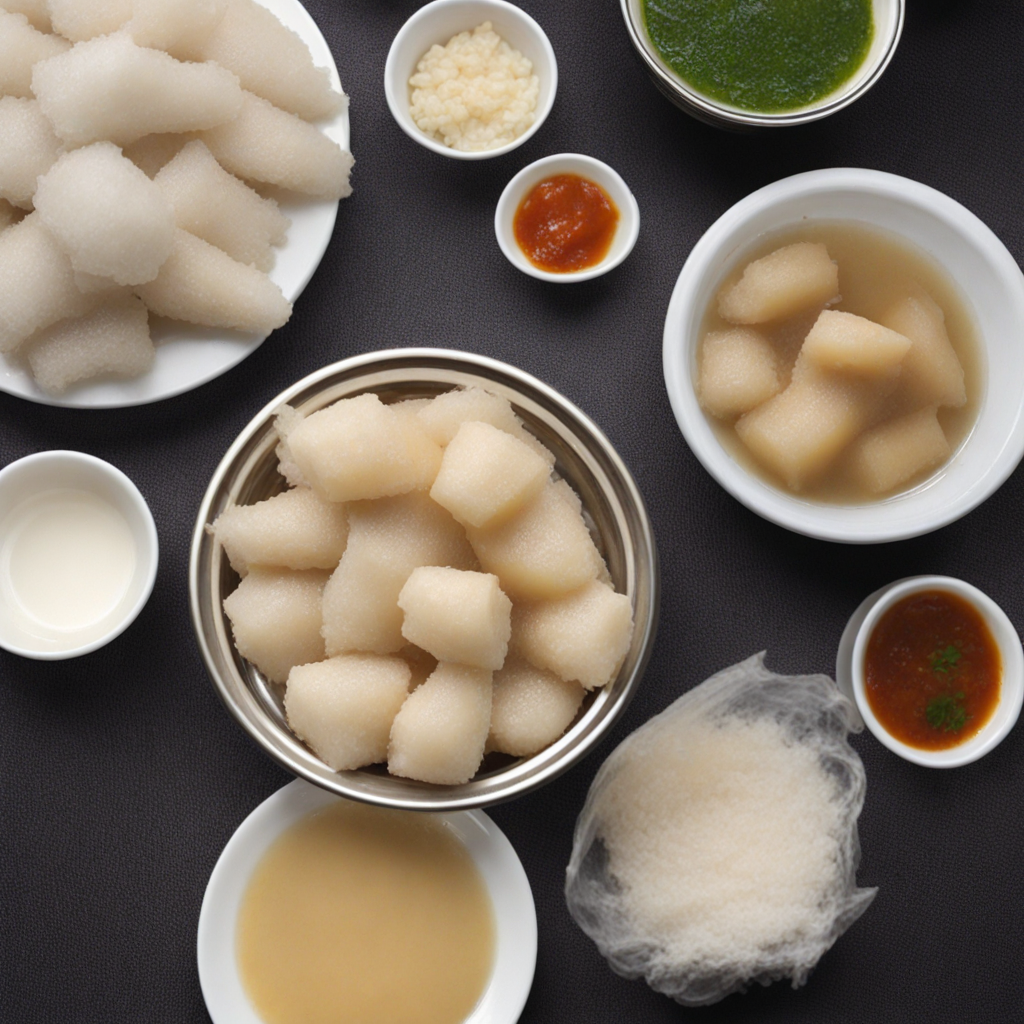Snail Stew
Snail Stew, known as "Escargot" in some cultures, is a unique and delightful dish from Nigeria that showcases the rich culinary heritage of the region. This hearty stew is primarily made from land snails, which are prized for their tender texture and rich flavor. The snails are usually cleaned and cooked in a savory broth that features a medley of local spices and herbs, such as crayfish, pepper, and groundnut paste. These ingredients come together to create a fragrant and mouthwatering base, making the dish an enticing option for those looking to explore new tastes and flavors. The preparation of Snail Stew involves slow cooking, which allows the flavors to meld beautifully. The snails absorb the spices and seasonings, resulting in a succulent dish that bursts with umami. Often served with a side of rice or yam, Snail Stew is a comforting meal that balances the earthiness of the snails with the vibrant notes of the accompanying ingredients. The stew's thick consistency is perfect for scooping up with your preferred starch, making every bite a delightful experience. In addition to its delicious taste, Snail Stew is also a source of protein and is believed to have various health benefits. The dish is often enjoyed during special occasions and gatherings, showcasing its cultural significance in Nigerian cuisine. For adventurous eaters and those eager to expand their culinary horizons, Snail Stew offers a rich tapestry of flavors and textures that surely deserves a place on your dining table.
How It Became This Dish
The History of Snail Stew in Nigeria Origins and Early History Snail stew, known locally in various Nigerian dialects as "Isiewu" or "Nkwobi," has a storied place in Nigeria's culinary tapestry. The use of snails in cooking can be traced back centuries, deeply rooted in the agricultural practices of early Nigerian societies. Snails, being abundant in the humid, tropical climate of Nigeria, became a readily available source of protein, particularly in the southeastern regions. The origins of cooking snails can be linked to the indigenous farming communities who recognized the mollusk's nutritional value. The Igbo people, in particular, have long celebrated snails not only for their taste but also for their purported health benefits. Traditional beliefs hold that snails are a source of vitality, and consuming them can enhance one's strength and stamina. Cultural Significance In Nigeria, food is much more than mere sustenance; it is interwoven with culture, identity, and community. Snail stew occupies a unique cultural niche, often associated with communal gatherings, celebrations, and traditional rituals. It is a dish that transcends mere consumption, embodying the spirit of togetherness and cultural heritage. The preparation and sharing of snail stew is often an event in itself. In many Igbo communities, it is customary to serve snail stew during significant occasions, such as weddings, festivals, and family reunions. The dish's communal nature fosters social bonds, as family and friends gather to enjoy the meal together. The act of preparing snail stew can also be seen as a rite of passage, particularly for young women learning the nuances of traditional cooking. The significance of snails extends beyond the kitchen; they are also part of folklore and traditional medicine. In some cultures, snails are associated with fertility and prosperity, and they feature in various proverbs and stories that convey moral lessons or cultural values. The reverence for snails in Nigerian culture is evident in the way they are celebrated in local cuisines and how they are viewed as symbols of abundance and good fortune. Development Over Time As Nigeria has evolved through colonialism, globalization, and urbanization, so too has the preparation and consumption of snail stew. The dish, traditionally prepared with local spices and herbs, has adapted to incorporate new flavors and cooking techniques influenced by a myriad of cultures that have interacted with Nigeria over the years. In the pre-colonial era, snail stew was primarily a rural dish. With the advent of colonial rule in the late 19th and early 20th centuries, urban centers began to emerge, and with them, new culinary landscapes. The introduction of European ingredients and cooking methods altered traditional recipes. While the core elements of snail stew remained intact, such as the use of palm oil, pepper, and various spices, the dish began to incorporate more diverse influences, reflecting Nigeria's growing urban identity. By the late 20th century, the globalization of food culture further transformed snail stew. With the rise of international travel and the internet, culinary exchanges became commonplace, leading to a fusion of flavors. Chefs and home cooks alike began experimenting with snail stew, introducing elements from other cuisines—such as the incorporation of tomatoes or even Western-style sauces, broadening the appeal of this traditional dish. Moreover, the rise of Nigerian diaspora communities around the world has propelled snail stew into the global culinary arena. Nigerian restaurants have sprouted up in major cities abroad, showcasing traditional dishes, including snail stew, to a wider audience. This has led to an increased appreciation for the dish and its cultural significance, allowing it to transcend geographical boundaries. Ingredients and Preparation The preparation of snail stew may vary significantly across Nigeria, reflecting regional ingredients and personal preferences. The basic components typically include snails, palm oil, ground crayfish, pepper (often a mix of Scotch bonnet and other local varieties), and spices like uziza seeds or locust beans (iru). Some variations may include vegetables or even meat to enhance the stew's flavor profile. The process of making snail stew often begins with the careful cleaning of the snails, which can be a labor-intensive task. Once cleaned, the snails are usually boiled or steamed to ensure they are tender. The stew is then created by sautéing the base ingredients—often onions, tomatoes, and peppers—before introducing the snails and allowing them to simmer in the rich, flavorful sauce. Serving snail stew is often accompanied by a staple food, such as rice, yam, or plantains, creating a well-rounded meal that is both satisfying and nutritious. The presentation of the dish, often garnished with fresh herbs, adds to its appeal, making it a feast for both the eyes and the palate. Contemporary Trends and Future Prospects In recent years, there has been a resurgence of interest in indigenous Nigerian cuisines, including snail stew, as health-conscious consumers seek out traditional dishes rich in flavor and nutrition. With the rise of organic and locally sourced food movements, snails, being a sustainable source of protein, have gained traction among eco-conscious diners. Additionally, with the increasing popularity of plant-based diets, snail stew has found a niche in vegetarian and vegan adaptations, where snails are substituted with plant-based alternatives. This culinary innovation speaks to the versatility of the dish and its continued relevance in contemporary food culture. The future of snail stew in Nigeria seems promising. As culinary traditions are passed down from generation to generation, the dish remains a cherished part of Nigerian heritage. With ongoing globalization, there is potential for snail stew to find its rightful place on the global culinary stage, celebrated not only for its unique flavors but also for its cultural story of resilience, community, and tradition. In conclusion, snail stew is not just a dish; it is a testament to Nigeria's rich agricultural heritage, cultural identity, and evolving culinary landscape. As it continues to adapt and thrive, it remains a delicious embodiment of the stories, traditions, and communal bonds that define Nigerian society.
You may like
Discover local flavors from Nigeria


